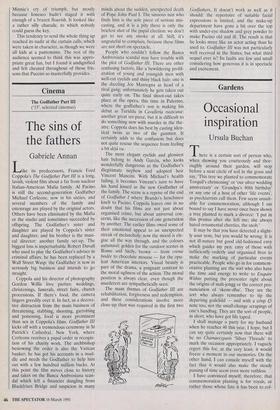Cinema
The sins of the fathers
Gabnele Annan
Like its predecessors, Francis Ford Coppola's The Godfather Part III is a long, lavish, violent film about a far from nuclear Italian-American Mafia family. Al Pacino is still the second-generation Godfather Michael Corleone, now in his sixties, and several members of the family and entourage are played by the original actors. Others have been eliminated by the Mafia or the studio and sometimes succeeded by offspring. The Godfather's sister and daughter are played by Coppola's sister and daughter, and his brother is the musi- cal director: another family set-up. The biggest loss is imperturbable Robert Duvall who used to play the Godfather's adviser in criminal affairs: he has been replaced by a Wall Street Wasp: the Godfather is now in seriously big business and intends to go straight.
Coppola and his director of photography Gordon Willis love parties: weddings, christenings, funerals, street fairs, church processions. If there's food, the camera lingers greedily over it. In fact, as a decora- tive distraction from the main business of threatening, stabbing, shooting, garrotting and poisoning, food is more prominent than sex in Coppola's films. Godfather III kicks off with a tremendous ceremony in St Patrick's Cathedral, New York, where Corleone receives a papal order in recogni- tion of his charity work. The archbishop bestowing the order is also the Vatican banker; he has got his accounts in a mud- dle and needs the Godfather to help him out with a few hundred million bucks. At this point the film moves close to history and takes on the Banca Ambrosiana scan- dal which left a financier dangling from Blackfriars Bridge and suspicion in many minds about the sudden, unexpected death of Pope John Paul I. The sinuous nun who finds him is the sole piece of serious mis- casting, and it is a pity there is only the briefest shot of the papal election: we don't get to see any smoke at all. Still, it's ungrateful to complain, because these films are not short on spectacle.
People who couldn't follow the Banca Ambrosiana scandal may have trouble with the plot of Godfather III. There are other confusing factors, like a bewildering prolif- eration of young and youngish men with well-cut eyelids and shiny black hair: one is the dazzling Joe Mantegna as head of a rival gang; unfortunately he gets taken out quite early on. The final shoot-out takes place at the opera, this time in Palermo, where the godfather's son is making his debut as Turiddu in Cavalletia rusticana: another great set-piece, but it is difficult to do something new with murder in the the- atre. Coppola does his best by casting iden- tical twins as two of the gunmen. It certainly adds to the confusion; but does not quite rescue the sequence from feeling a bit deft) vu.
The most elegant eyelids and glossiest hair belong to Andy Garcia, who looks wonderfully dangerous as the Godfather's illegitimate nephew and adopted heir Vincent Mancini. With Michael's health failing, it becomes Vincent's turn to have his hand kissed as the new Godfather of the family. The scene is a reprise of the end of Godfather I where Brando's henchmen knelt to Pacino. Coppola leaves one in no doubt that his films are not just about organised crime, but about universal con- cerns, like the succession of one generation by another. The earlier films owed some of their emotional appeal to an unexpected streak of melancholy; now the mood is ele- giac all the way through, and the colours autumnal: golden for the outdoor scenes in Rome and Sicily, brown — from creme bndee to chocolate mousse — for the opu- lent American interiors. Visual beauty is part of the drama, a poignant contrast to the moral ugliness of the action. The moral position is always clear, even though the murderers are sympathetically seen.
The main themes of Godfather III are rehabilitation, forgiveness and redemption, and these considerations involve more close-up than was required in the first two
Godfathers. It doesn't work as well as it should: the repertoire of suitable facial expressions is limited, and the make-up department have gone a bit over the top with under-eye shadow and grey powder to make Pacino old and ill. The result is that he looks more like an actor acting than he used to. Godfather III was not particularly well received in the States; but what third sequel ever is? Its faults are few and small considering how generous it is in spectacle and excitement.


























































 Previous page
Previous page